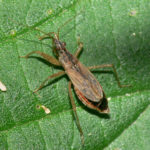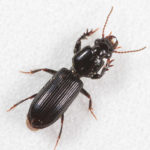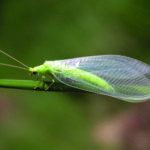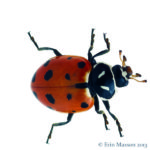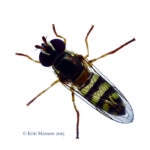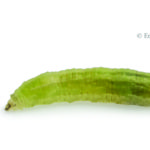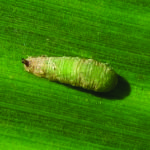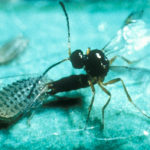Click for full PDF publication
Introduction
- Intro
- Integrated pest management
- Protecting bees and other pollinators
- Phytotoxicity precautions
- Policy statement on pest management suggestions
Authors
Allen Knutson
Professor and Extension Entomology Specialist
Robert Bowling
Assistant Professor and Extension Entomology Specialist
Vanessa Corriher-Olson
Associate Professor and Extension Forage Specialist
The Texas A&M University System
Acknowledgments
Mark Muegge, Extension Entomologist, contributed to this publication, and this revision is dedicated to his memory.
Charles Allen, Professor and Extension Entomology Specialist, reviewed this publication.
Intro
This publication discusses integrated pest management (IPM) practices for insect pests of Texas forage crops, including bermudagrass hay and pasture, forage sorghum, alfalfa, clover, and vetch.
For information on insect pests of small grains, which sometimes are grown as forage crops, see Managing Insect and Mite Pests of Small Grains in Texas, publication E-399, which is available from the county Texas A&M AgriLife Extension office or online at agrilifelearn.tamu.edu.
Integrated Pest Management
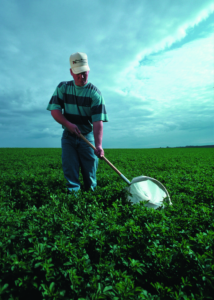
IPM is a sustainable pest-management approach that combines biological, cultural, physical, and chemical tools in a way that minimizes economic, health, and environmental risks. IPM combines the most economical and ecologically sound techniques to control insect and mite pests efficiently and effectively.
IPM tactics include:
- Cultural practices, such as fertilizing, rotating crops, and planting cultivars with pest resistance
- Biological control, which protects the pests’ natural enemies
- Chemical control, which is the judicious use of selected insecticides and rates to keep pest numbers below economically damaging levels
For example, planting adapted and pest-resistant cultivars can help control some dis- eases of alfalfa as well as pea aphids, blue alfalfa aphids, and spotted alfalfa aphids.
For ratings of pest resistance of alfalfa varieties, along with their winter hardiness and dormancy characteristics, see Winter Survival, Fall Dormancy and Pest Resistance Ratings for Alfalfa Varieties, by the National Alfalfa and Forage Alliance, at http://alfalfa.org/pdf/2011NAFAVariety- Leaflet_small.pdf.
A vital component of IPM is the use of insecticides because they can quickly reduce a pest population to prevent crop loss.
Apply insecticides when plant damage or pest populations approach levels that can cause crop losses that are greater than the cost of the insecticide treatment. This pest density or plant damage level is called the economic threshold or action level.
Another essential is to inspect fields regularly—once or twice a week—to assess crop growth, pest damage, and pest and beneficial insect populations (Fig. 1). This information will enable you to determine whether the pest is at the action level, which is when you may need to use an insecticide or take other management action to prevent economic loss.

When using insecticides, always read and follow the directions on the product label. A critical practice is to rotate insecticides that attack pests in different ways. Insecticides are classified according to their modes of action—the ways that they kill insect pests.
For example, some chemicals disrupt the feeding behavior of the insect, which then starves to death. Other pesticides paralyze insects, and still others prevent them from reproducing.
In most pest populations, a few individuals have genes that allow them to survive the pesticide; these insects are termed resistant to the pesticide. When pesticides with the same mode of action are used repeatedly, the proportion of resistant individuals increases as they pass on their resistant genes to their offspring.
The selection of insects with resistance occurs more quickly if pesticides with the same mode of action are used repeatedly. To help prevent insecticide resistance, use insecticides only when necessary, and rotate insecticides with those having different modes of action.
To determine an insecticide’s mode of action, refer to the product label. Each mode of action is identified numerically by group; some are also identified alphabetically by subgroup (Fig. 2). For example, the classification 1B refers to organophos- phates that attack the insect’s nervous system; class 7 insecticides disrupt insect growth and development.
Rotate insecticides with different mode-of-action numbers. Rotating by brand name may not be effective because the same active ingredient (and the same mode of action) is often sold under different brand names.
Weather, natural enemies, and lack of food often keep pest infestations below econom- ically damaging levels. Common natural enemies in forage crops include damsel bugs, ground beetles, lacewing larvae, lady beetles, pirate bugs, spiders, syrphid fly larvae, and a variety of tiny wasps that parasitize many forage crop pests (Figs. 3 through 13).
Other natural enemies are the bacteria, fungi, and viruses that cause diseases in some pests, including grasshoppers.
When possible, use pesticides that are effective against the pest but less harmful to its enemies.
Protecting bees and other pollinators
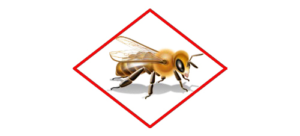
box on the pesticide label, which details
restrictions on pesticide use that protect
bees and other pollinators
Alfalfa, clover, and vetch in bloom are very attractive to honeybees and other insect pollinators. These pollinators also forage in sorghum fields for pollen and on flowering weeds in and around fields.
When possible, use pesticides that are less toxic to bees. However, most of the insecticides listed in this publication are highly toxic to bees. Exceptions include Sivanto Prime and insecticides applied as baits for fire ant control.
Bees can be killed on contact with some insecticides and their residues on or in plants. Help prevent bee poisoning by applying insecticides late in the evening or at night when bees are not foraging in the field.
Also, avoid insecticide drift, which can contaminate blooming plants in and around the field. Avoid pesticide drift onto bee colonies. Bees often cluster on the front of hives during hot evenings. Pesticide drift onto clustering bees can result in high mortality. The producer, applicator, and beekeeper should cooperate closely to minimize bee mortality.
For directions and restrictions to protect bees and other insect pollinators, read the “Directions for Use” section of the product label. On new labels, this information is listed in a bee advisory box and noted by the bee icon (Fig. 14).
Phytotoxicity Precautions
Some insecticides are poisonous, or phytotoxic, to plants. For example, some pesticides stunt the plants and burn the leaves of certain sorghum hybrids, especially seed sorghums.
Before applying a pesticide, check the label closely for possible phytotoxic effects. This information is also available from the chemical manufacturer and the seed company.
Policy statement on pest management suggestions
The information and suggestions in this publication reflect the opinions of Extension entomologists based on research, field tests, and experience. Because the management suggestions are a product of research, they are believed to be reliable.
However, it is impossible to eliminate all risk. Even when these suggestions are used, unforeseen or unexpected conditions or circumstances may lead to unsatisfactory results. The Texas A&M AgriLife Extension Service assumes no responsibility for risks. Such risks shall be assumed by the user of this publication.
Suggested pesticides must be registered and labeled by the U.S. Environmental Protection Agency and the Texas Department of Agriculture. The status of pesticide label clearances is subject to change and may have changed since this publication was published.
Always read and follow carefully the in- structions on the container label. The user is always responsible for the effects of pesticide residues on livestock and crops, as well as for problems that could arise from drift or other movement of the pesticide to others’ property.
